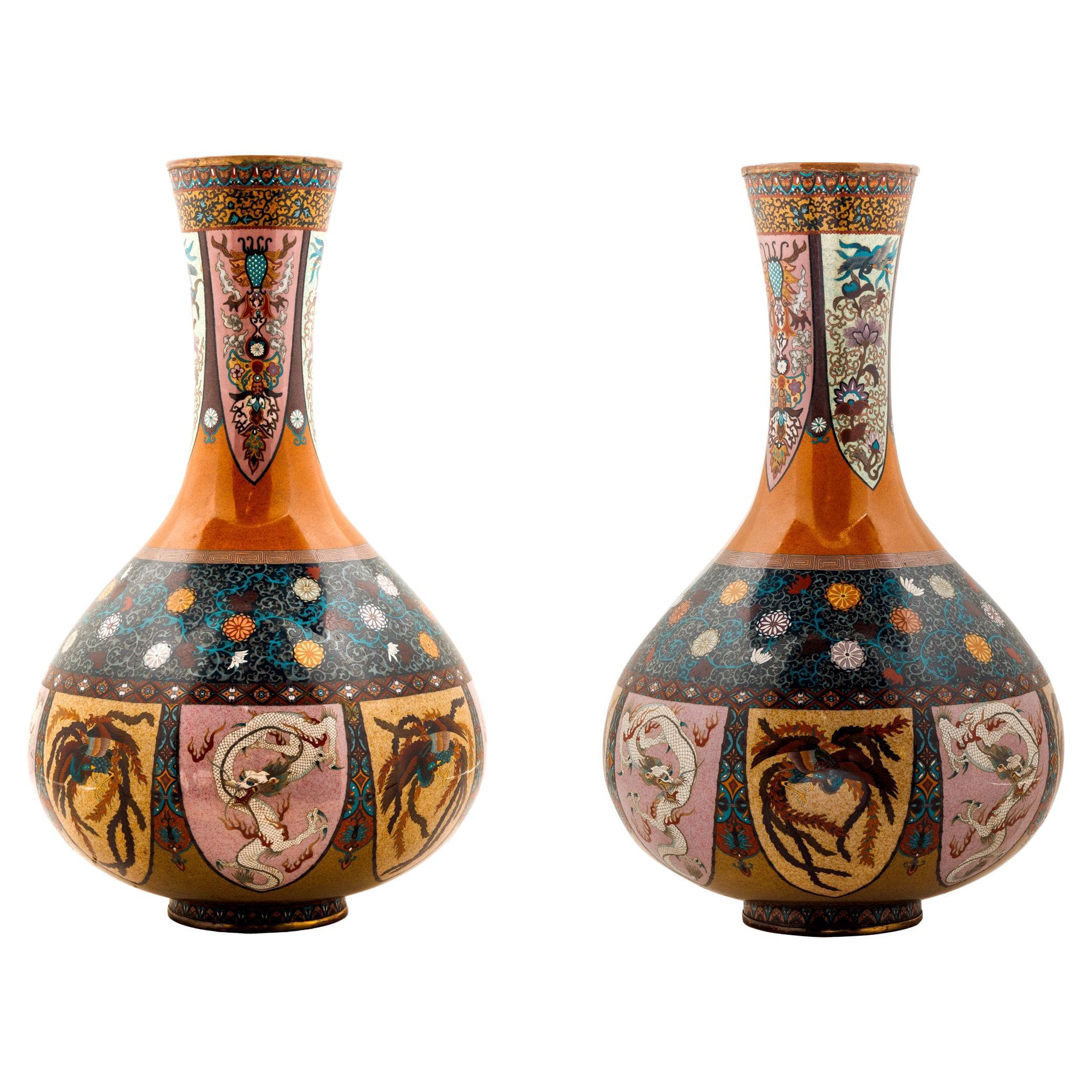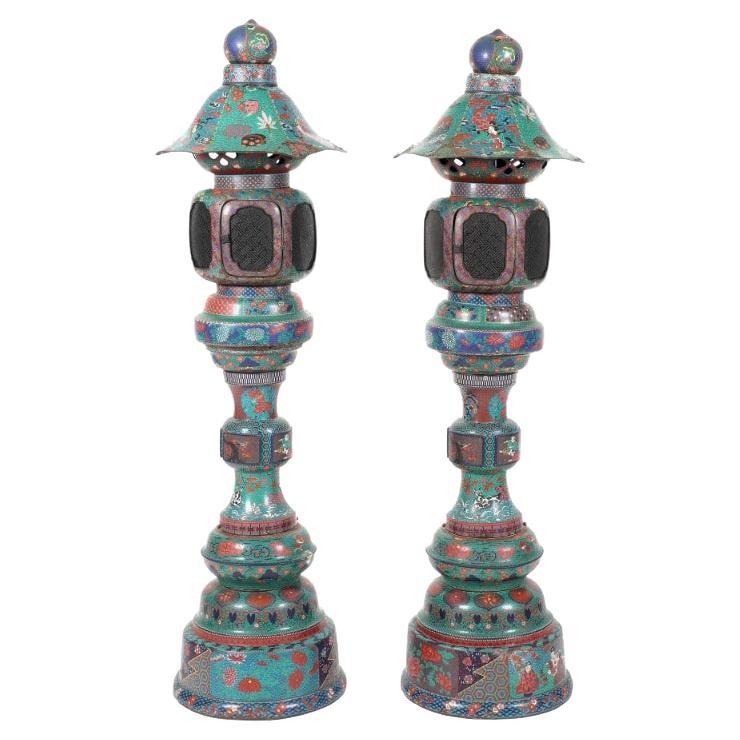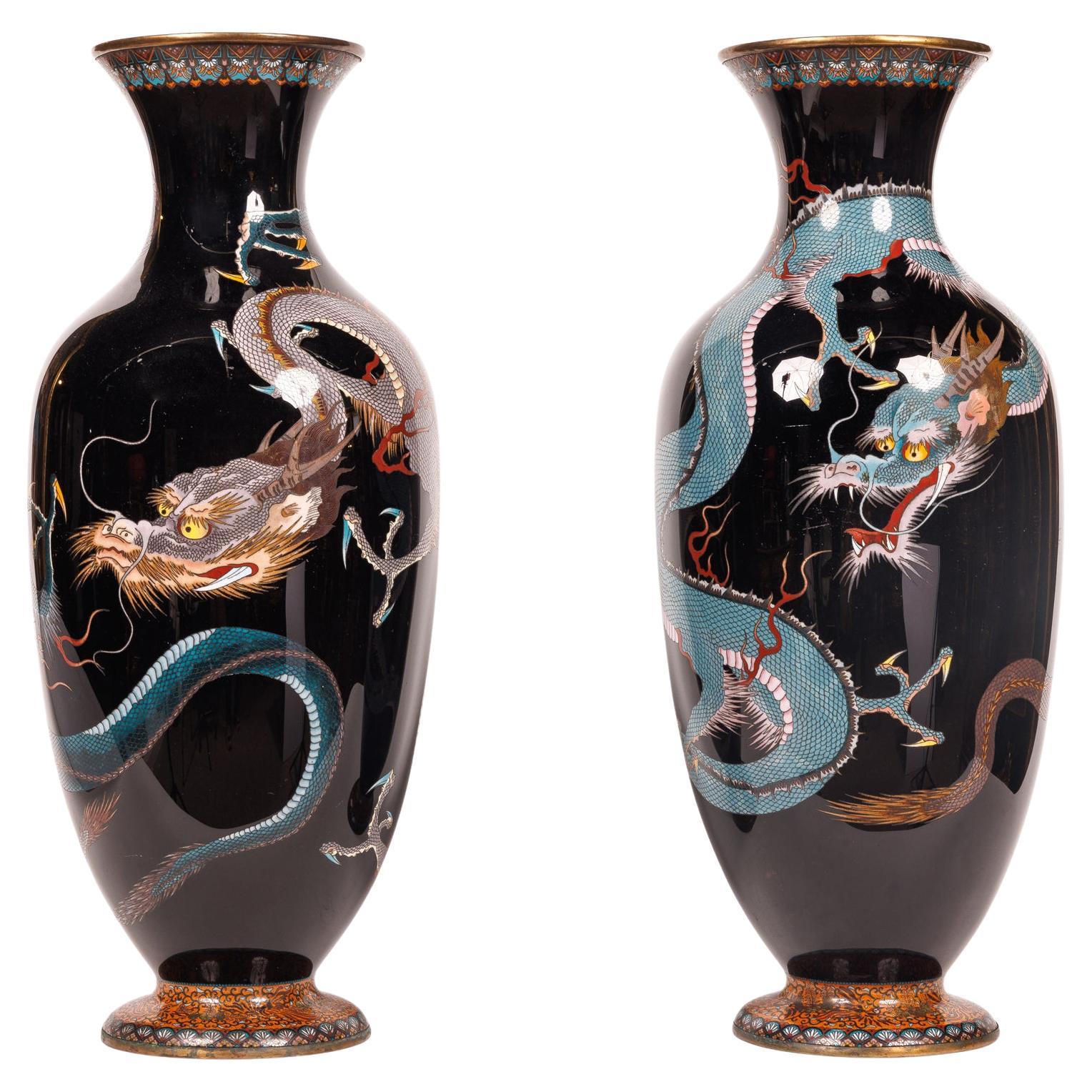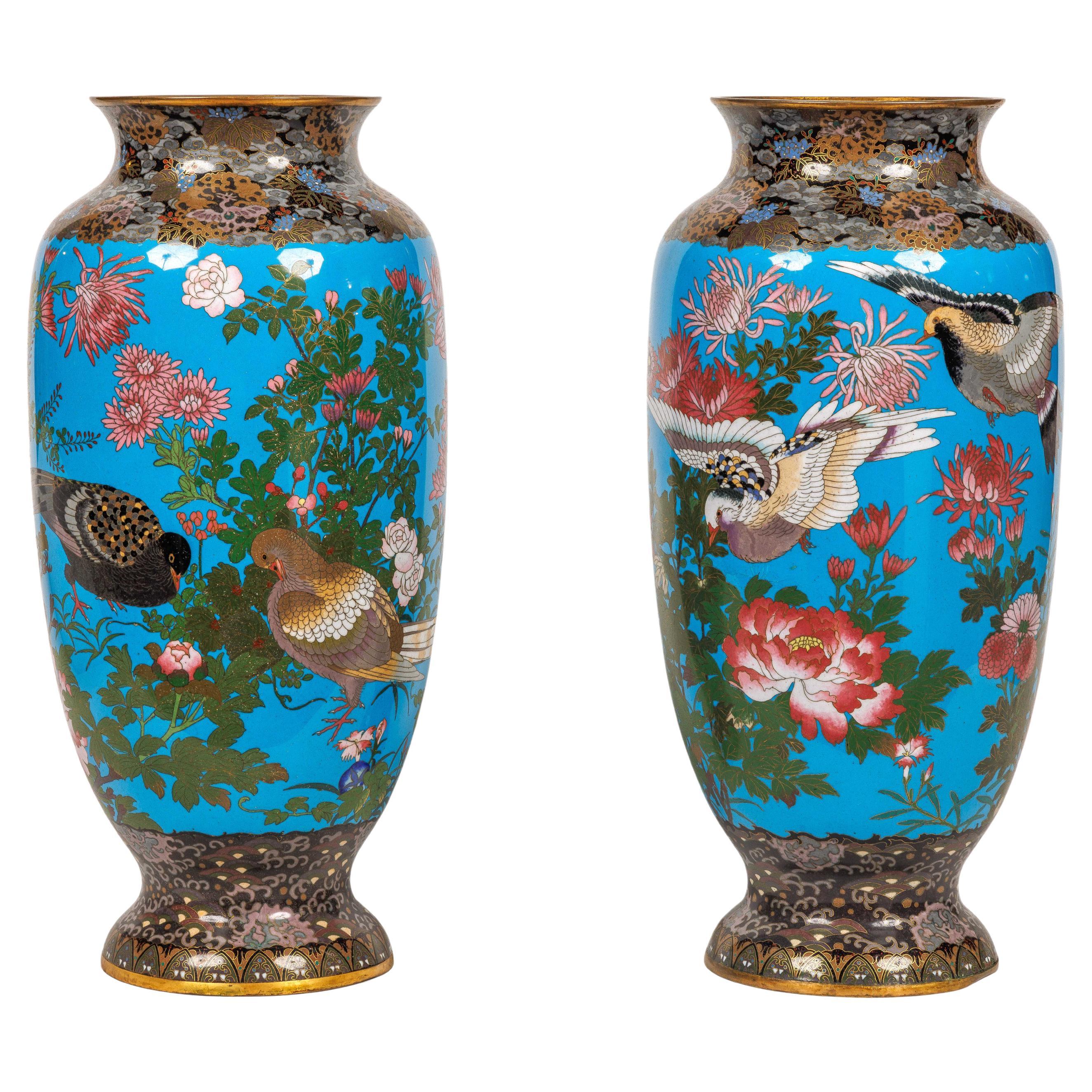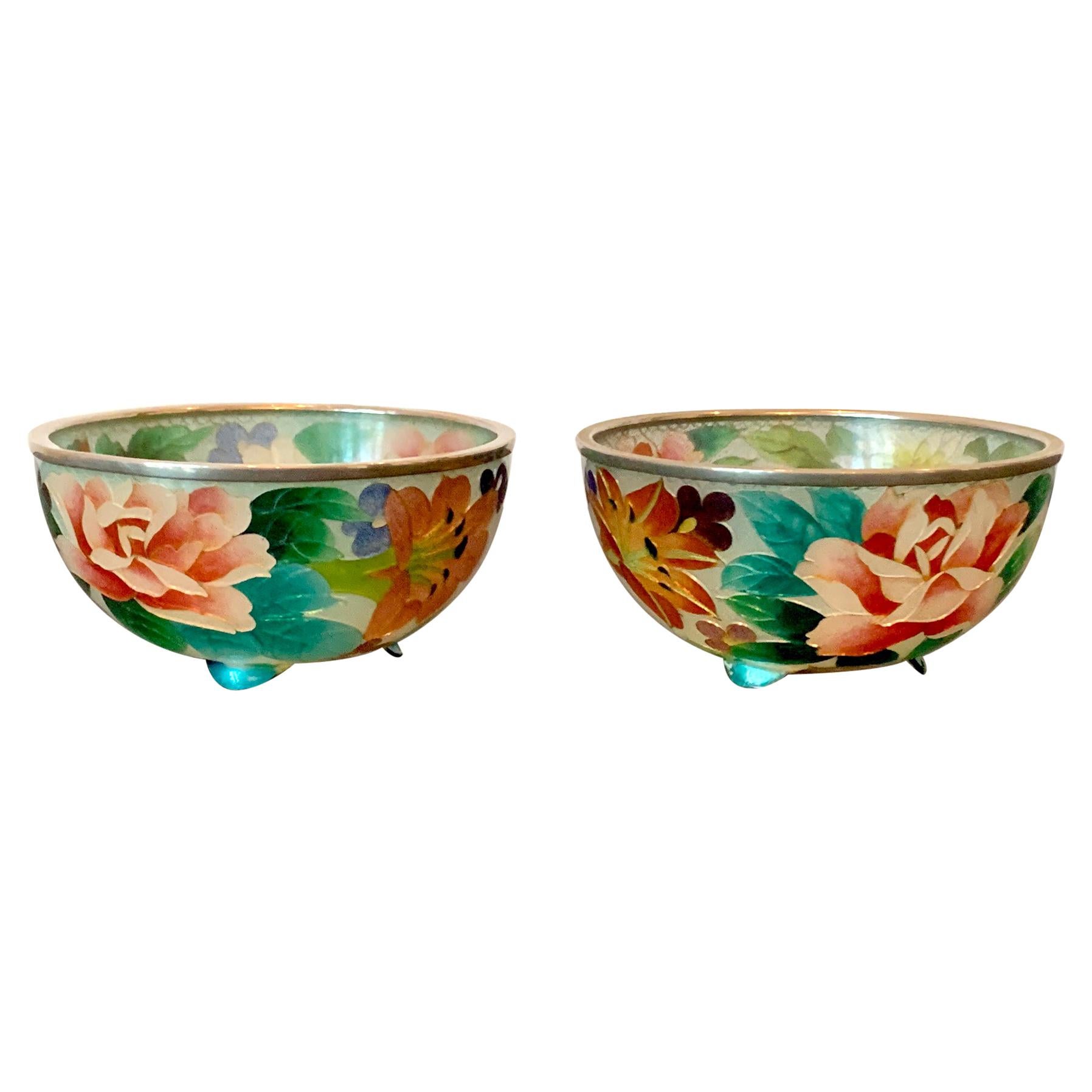Items Similar to Pair of Large Chinese Cloisonné Plique-à-Jour Bowls
Want more images or videos?
Request additional images or videos from the seller
1 of 13
Pair of Large Chinese Cloisonné Plique-à-Jour Bowls
About the Item
A large pair of Chinese cloisonné enamel bowl made with the technique of plique-à-jour (means "letting in daylight" in French), a challenging method similar to small scale stained windows originally developed in the Byzantine Empire in 6th century AD. Using no backing and translucent enamel, it creates jewel-like piece.
This pair of bowl is of identical copper wire construction with a matching design. The main colors slightly differ with one in green the other blue. The copper based cloisonné cells feature large and small peony branches on a background of leave pattern. The miniature compartments "cells" were filled with enamels of different colors to precisely carry out the auspicious design while letting the light through. The design was also facilitated with many delicately pierced "cells" that further gives the pieces a very airy appearance.
- Dimensions:Height: 3.85 in (9.78 cm)Diameter: 8 in (20.32 cm)
- Style:Chinoiserie (Of the Period)
- Materials and Techniques:
- Place of Origin:
- Period:
- Date of Manufacture:1920s-1950s
- Condition:Wear consistent with age and use. No breakage or losses of enamel. Slight oxidation on metal wire and rims. One bowl may be slightly misshaped.
- Seller Location:Atlanta, GA
- Reference Number:1stDibs: LU945021742692
About the Seller
5.0
Platinum Seller
These expertly vetted sellers are 1stDibs' most experienced sellers and are rated highest by our customers.
Established in 2006
1stDibs seller since 2010
479 sales on 1stDibs
Typical response time: <1 hour
- ShippingRetrieving quote...Ships From: Atlanta, GA
- Return PolicyA return for this item may be initiated within 2 days of delivery.
More From This SellerView All
- Pair of Early Japanese Plique-a-Jour Bowls from NagoyaBy Ando JubeiLocated in Atlanta, GAA pair of small but exquisite Plique-a-jour cloisonné bowls with nearly identical design from Nagoya area in Japan circa 1900-20s. Maker's unknown but possibly by Ando company. The t...Category
Early 20th Century Japanese Japonisme Metalwork
MaterialsMetal, Enamel
- Chinese Plique-a-Jour BowlLocated in Atlanta, GAA small Chinese cloisonne enamel bowl made with the technique of Plique-a-jour (means "letting in daylight" in French), a challenging method similar to small scale stained windows...Category
20th Century Chinese Chinese Export Metalwork
MaterialsCopper, Enamel
- Chinese Plique-a-jour Archaic Style BowlLocated in Atlanta, GAA small Chinese cloisonné enamel bowl made with the technique of Plique-a-jour (means "letting in daylight" in French), a challenging method similar to small scale stained windows or...Category
20th Century Chinese Chinese Export Metalwork
MaterialsCopper, Enamel
- Pair of Japanese Bronze Vase with Metal Inlays by MitsufuneLocated in Atlanta, GAA pair of elegant vases of solid oiled bronze from the Meiji era, Japan (1868-1912). In a Classic Meiping shape, the pair has a mirrored inlay with gold, silver and red enamel that d...Category
Antique Late 19th Century Japanese Japonisme Metalwork
MaterialsBronze
- Antique Japanese Iron Stirrups with Silver Inlay SignedLocated in Atlanta, GAA pair of antique Japanese Abumis, stirrup for horse-riding, in cast iron with elaborate silver inlay, circa 16th century Muramachi to Momoyama period. The prototype of Japanese abum...Category
Antique 16th Century Japanese Japonisme Metalwork
MaterialsSilver, Iron
- Collection of Three Korean Antique Bronze BowlsLocated in Atlanta, GAA collection of three bronze bowls from Korean dated to 14-17th century (late Goryeo to early Joseon Dynasty). It consists of an early example with a slight curvy wall and a high foo...Category
Antique 16th Century Korean Other Metalwork
MaterialsBronze
You May Also Like
- Large Pair of Japanese Cloisonne Enamel Vases Attributed to Honda YasaburoLocated in New York, NYA large pair of Japanese Cloisonne Enamel vases attributed to Honda Yasaburo, 19th century. Finley decorated with the rich enamel colors of orange and green, these vases are desig...Category
Antique 19th Century Japanese Meiji Metalwork
MaterialsCopper, Enamel
- Large Pair of Japanese Cloisonne Enamel Lanterns Attributed to Kaji TsunekichiLocated in New York, NYA Large Pair of Japanese Cloisonne Enamel Lanterns Attributed to Kaji Tsunekichi, Edo Period, 19th century Japanese cloisonne lanterns were made during the Meiji period, from the late 19th to early 20th century, and were often used as decorative lighting fixtures in temples and shrines. Kaji Tsunekichi (1866-1916) was a Japanese cloisonné artist who was active in the late 19th and early 20th centuries. He was born in Tokyo and learned the art of cloisonné from his father, Kaji Sataro, who was also a cloisonné artist. He was renowned for his mastery of the shippo-yaki technique, which involves creating intricate designs with thin wires on a metal base before filling in the spaces with enamel. Tsunekichi was known for his exceptional technical skills and his ability to create intricate designs with vibrant colors. His works often featured nature motifs, such as flowers, birds, and fish, which were rendered in a highly detailed and naturalistic style. He also experimented with new techniques, such as plique-à-jour, a type of cloisonné that creates a stained-glass effect. Tsunekichi's works were highly prized during his lifetime and continue to be sought after by collectors today. He won numerous awards for his cloisonné creations, including a Gold Medal at the 1900 Exposition Universelle in Paris. His works are characterized by their fine wirework, precise enamel application, and attention to detail. Some of Tsunekichi's most famous works include a pair of large cloisonné vases...Category
Antique 19th Century Japanese Edo Metalwork
MaterialsCopper, Enamel
- Large Pair of Meiji Period Japanese Cloisonne Enamel Double Dragon VasesLocated in New York, NYA large pair of Meiji Period Japanese Cloisonne Enamel Double Dragon Vases, 19th century. Japanese cloisonne enamel dragon vases are highly ...Category
Antique 19th Century Japanese Meiji Metalwork
MaterialsCopper, Enamel
- Large Pair of Meiji Period Japanese Cloisonne Enamel Vases Attributed to GotoLocated in New York, NYA large pair of Meiji Period Japanese cloisonne enamel vases attributed to Goto Seizaburo, 19th century. These vases were made during the Meiji period (1868-1912) in Japan and are...Category
Antique 19th Century Japanese Meiji Metalwork
MaterialsCopper, Enamel
- Large Meiji Period Cloisonne Enamel KoroLocated in London, GBLarge Meiji Period Cloisonne Enamel Koro Japanese, late 19th Century Height 88cm, width 76cm, depth 53cm This superb cloisonne enamel koro was made during Japan's Meiji period, and ...Category
Antique Late 19th Century Japanese Meiji Metalwork
MaterialsBronze, Enamel
- A Fine Pair Pair of Japanese Cloisonne Enamel Oviform Vases. Meiji period.Located in London, GBA Magnificent Pair of Japanese Cloisonne Enamel Oviform Vases 19th Century Meiji period A Pair of Japanese cloisonné enamel oviform vases worked with silver wire and decorated wit...Category
Antique Late 19th Century Japanese Metalwork
MaterialsEnamel
